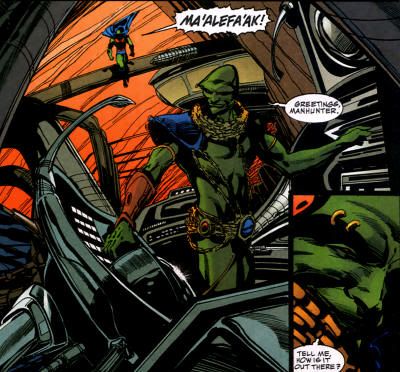 Forensic Psychiatrist Dr. Michael Stone's Scale of Evil Rank
Forensic Psychiatrist Dr. Michael Stone's Scale of Evil Rank
22)
Psychopaths who inflict extreme torture on their victims and then murder them.
Why Malefic has been selected for 2nd Place:
- Malefic is the Martian Manhunter villain in the eyes of modern readers.
Most people know J’onn J’onzz best through his association with the Justice League of America, rather than as a solo hero. That means that the Martian Manhunter’s small pre-Crisis rogues’ gallery was left to antiquity, and he usually shares his less dusty foes with the League. It was thanks to the runaway success of
JLA that a solo spin-off for the Alien Atlas managed to launch in the near six digits. There at the beginning was Malefic, introduced to new and veteran readers as J’Onn J’Onzz’s greatest and longest-lived foe, despite having just been made up. Old fans could harp on older foes, but few had made any appearances in decades, and new blood was necessary to the survival of the series. Meanwhile, younger readers, or folks unfamiliar with the DC Universe brought in by
JLA, likely assumed Malefic was always a part of the Martian Manhunter’s story. For both these reasons, Malefic remains J’Onn’s go-to nemesis, despite having been killed in his first story arc and not making any successive appearances outside of flashbacks or other contrivances.
- Malefic was the aberrant Martian his own mother wouldn’t love.
When you come from a race built around societal unity of mind, body and spirit, there’s no worse fate than being the odd man out. From birth, Ma’alefa’ak was set apart by his very name and the dire visions of his future revealed by his own mother. Supposedly, being named after the darkness of the heart and having a twin brother designated as Mr. Perfect was supposed to be for Ma’alefa’ak’s own good, but did anybody stop to consider how twisted his mother must have been to place such a traumatic burden on her offspring? Maybe she was carrying some sort of psychological cancer within herself that she intentionally imparted to her wayward son. Regardless, she cursed Malefic, blamed him when anything went wrong, was too slow in her bid to mind rape him, and was instead left a vegetable her own self. Every Martian but J’Onn, including Ma’alefa’ak’s own father, were made to fear and distrust him. Maybe Malefic really was born bad, but Mars went out of its way to consistently fuel his deviant fire.
- Malefic understands the principle of better bonding through torture.
Grant Morrison isn’t very good about doing research. He unintentionally resurrected non-Green Martian races because he didn’t know they had been exterminated and written out of continuity. Then he decided to form a new Injustice Gang to parallel his pantheistic JLA, and instead of digging up a legitimate Martian Manhunter enemy (or just use Despero like everyone wanted,) he extorted the services of the obscure alien super-hero Jemm, Son of Saturn. At the end of Morrison’s arc, Jemm was written off as an injured party without offering any substantial explanation for his usage or fate. Luckily, John Ostrander picked up the thread early in his
Martian Manhunter solo series. It was revealed there that Jemm had been exiled from his people, and was being rehabilitated out of a recently uncovered Martian Earth base called Z’onn Z’orr.
While following a trail of death Malefic had begun, J’Onn J’Onzz discovered that Jemm had been tortured for some time by himself, or rather Malefic impersonating the Martian Manhunter. Jemm again needed physical and psychological recovery, and J’Onzz had to explain his relationship with Jemm, or more to the point, Ancient Martians having created the Saturnian race as a clone work force. Without Malefic’s having used Jemm as part of his vendetta against his brother, readers may have never had this key relationship explained, and the torture also bonded Jemm and J’Onn on a personal level that expanded their individual franchises through the connection. Malefic made Jemm the Patty Hearst of comics, and allowed the Martian Manhunter to reclaim a useful continuity he had heavily influenced, but previously been excised from.
- Malefic altered the relationship between J’Onn, Jemm and the DC Universe.
In an extension of the previous point, not only did Malefic revive Jemm’s literary world after nearly fifteen moribund years, but his manipulations likely changed Jemm from a pacifistic “E.T.” style alien visitor to an ornery regent that actively engages the DC Universe in books like
The Rann/Thanagar War and
Superman: World of New Krypton. This resurgent usage of Jemm thanks in part to Malefic also altered Jemm’s personality enough that he actually could serve in the adversarial capacity against Martian Manhunter he was intended to play in the
JLA story that restored him as a contemporary character (not to mention continuing his clashing with Superman.)
- Malefic emphasized horror as a major genre component of solo Martian Manhunter stories.
When the Manhunter from Mars was introduced, there was a xenophobic element common to the Red Scare on the 1950s. Still, the atomic age was an optimistic time, so that the Manhunter served as a self-motivated beneficial “border patrol” against unruly illegal aliens on American shores. Mars itself was a clean, sunny, peaceful planet. It wasn’t until the Bronze Age that Martians faced dystopia related to the zeitgeist of rampant fears related to the environment, population explosion, diminishing global resources, and the ever present specter of nuclear annihilation. By the 1980s, most science fiction was heavily diluted by fantasy (
Star Wars,) militaristic action (
Predator) or horror (
The Fly.) The Martian Manhunter instead detoured into introspective territory that recalled the more respectable genre material of the ‘60s & ‘70s. The mature-themed
American Secrets reached further back, to sophisticated noir and sci-fi of the ‘50s.
It wasn’t until the mid-90s that Peter Tomasi began introducing horror-heavy material into solo Martian Manhunter stories, first as a writer, and then editor. The primary vehicle for this change was the character of Malefic, whose very name indicates his tendency toward extreme, graphic depictions of physical and psychological torture, as well as grotesque body alteration. While there were often elements of the occult and the appearance of monstrous entities in 1960s
Manhunter from Mars strips, Malefic retroactively enshrined them as part of the Martian Manhunter’s origins, and a constant element of his only solo series to date.
- Malefic looks like an evil Martian Manhunter.
N’or Cott was indistinguishable from J’onn J’onzz except for wearing more clothing, and all those thought balloons about planning to kill J’onn J’onzz. Re’s Eda looked like J’onn sometimes, and that doofy helmet made it clear he was a Napoleonic type. The Marshal looked an awful lot like the Martian Manhunter, but his bulk and body armor marked him as a fascist. B’enn B’urnzz was the spitting image of J’onn J’onzz, except for the scowl. B’rett was the spitting image of B’enn B’urnzz, except yellow and gun-toting. There are plenty of not so nice versions of our hero. However, none of them fully sold the evil.
Malefic also bore a strong family resemblance, but he was much too lean and elongated to appear heroic. He had all those piercings and chains, plus the face-obscuring chest piece. Most importantly, Malefic always had a wicked grin and cruel eyes that cleared up any ambiguity. Anyone who sees Malefic knows he’s pure evil, and anyone familiar with the Martian Manhunter knows this is his evil opposite just by looking. Image counts, and Malefic is the most visually adulterated variation on J’Onn J’Onzz to date.
- Malefic assaulted the Justice League.
There’s long been a subsection of Martian Manhunter fandom that looks at the sheer quantity of his abilities and expects him to be the most powerful member of the Justice League. Unfortunately, efficacy remains J’Onn J’Onzz’s greatest weakness, because it isn’t what you’ve got, but how you use it. Malefic proves this point, by trading blows with a League at peak strength and coming out looking like a serious menace. Admittedly, Malefic traded on stealth and deception to essentially team-up with his brother for the task, but Ma’alefa’ak’s example shows what the Alien Atlas could do if he ever truly stepped up. In this way, not only does Malefic prove his worth as a universally recognizable threat of considerable potency, but he also lends esteem to J’Onn J’Onzz through their comparable abilities.
- No man escapes the Manhunter from Mars.
Certain types of creators and the majority of editors are always looking for an angle to boost their profile/sales, regardless of the collateral damage. These are the ones who figure Hal Jordan should personally massacre the entire Green Lantern Corps, and when that works, maybe Tony Stark should also dabble in a bit of murder. The Martian Manhunter, reserved decades loyal fatherly figure amongst the Justice League and lacking his own title/editor, has been known to come up when a shock value traitor seems desirable. Cooler heads and J’Onzz’s modest Q Score tend to prevail, but the terminally infectious concept lies in wait like staphylococcus in the JLA’s literary body. The benefit of a villain like Malefic being around is that he affects the premise without corrupting the source. If Malefic is a remorseless, entirely uninhibited perpetrator against all life while wielding the Martian Manhunter’s full range of powers (as he would in a contemporary return with his telepathy restored,) there’s far less thrill in seeing J’Onn J’Onzz doing the same-- only fan flack. As the Flash put it, “Given who J’Onn is and what he represents to us—if we had to fight him, we’d lose, even if we won.” The same is true for fans, because there’s already an established evil Manhunter if you need one, and the ruination of a well regarded character if you choose not to employ Malefic for the task.
- Malefic started a new continuity
It could be argued that the appearance of the Hyperclan began the modern age of Martian continuity, but because they were an ancient race that predated J’Onn J’Onzz’s time, they didn’t actually negate prior history. However, introducing an entirely new sibling and having J’Onn J’Onzz pursue Ma’alefa’ak as the equivalent of a Martian policeman clearly contradicts the Post-Crisis history laid down in 1988. While much of what J.M. DeMatteis established held true, enough was changed to qualify as a post-Zero Hour revamp, largely centered on the changes Malefic demanded.
- Malefic continues the spirit of the Phantom Zone Criminals.
John Byrne’s relaunch of Superman threw the baby out with the bathwater, continuing a flaw begun in the movies of making Clark Kent a heartland take on Spider-Man, and essentially abandoning the soul of Kal-El. Thankfully, an unexpected result was that the Martian Manhunter went from a mildly derivative Superman type to the heir apparent of the extra-terrestrial pathos Superman shed. The Weisinger years were hugely influential on comics, with the Phantom Zone Criminals just one fascinating concept that doesn’t seem to function under the modern terms. However, as his brother carried on one tradition, Malefic paralleled the likes of Jax-Ur and Zod. Sentenced for heinous crimes on the hero’s home planet within a crystal cage, released in the present as a rare survivor to rampage on Earth, a legacy of personal animosity based on the imprisonment… the only major differences are that, as usual, J’Onn J’Onzz is more Jor-El than Kal, and that Ma’alefa’ak isn’t Caucasian.
- Malefic molested and executed everyone J’Onn J’Onzz held dear.
Malefic mind raped J’Onn’s new wife, psychically lobotomized their mother, initiated the events that saw their father dead, and created a plague that saw almost every Martian dead, including J’Onn’s daughter. Worse, as Ma’alefa’ak’s steadfast defender, J’Onzz is responsible for allowing his brother the life and liberty to accomplish all these horrors.
- Malefic killed all the other Martians.
Malefic got up to all kinds of sick business, was stripped of his memories and telepathy as punishment, then used his handicap to immunize himself against a psychic plague of his own creation. That’ll get you in the history books.
- Malefic was the single worst Martian ever.
Malefic is the plague rat. He killed all his people, and most of his family. He tried to frame and murder his brother and his friends. He’s a mind rapist, targeting his sister-in-law. He worships Darkseid as his God, in turn undermining the independence of Martian history, and helped to inspire the Anti-Life Equation that has cost countless lives. He’s a creepy walking, insane talking 1990s cliché. There’s pretty much no redeeming quality to Ma’alefa’ak.
 The Counter Argument:
The Counter Argument:
- Malefic is an inorganic construct. He fits perfectly into an archetypal model because there’s no individual personality present. Malefic is pure formula and would make Robert McKee proud.
- Malefic has been dead since 1998, and only turned up in a couple of flashback stories since.
- The EXTREME evil Martian with the piercings and the chains who makes with the stabby/slashing and is just sooooooo bad for no good reason besides he’s crrr-azy? Stop the ‘90s, I want to get off.
- Horror? You’re going to take a giant green Martian in a cape and trunks with a history in juvenile fiction and put him into horrific situations? I bet you wish someone would turn Wally Wood’s Disney Memorial Orgy into a series as well.
- Malefic’s big splash was to kill John Jones’ partner of a few recent issues and to claim credit for a plague that was canonized as naturally occurring a decade prior. Even when you factor in that a new continuity was begun, it’s still a body count of NPC asparagus people.
- Malefic killed J’Onn’s mother, contributed to the death of their father, mind raped his wife, tortured his quasi-nephew, unleashed a lethal plague against their people… why not kick his dog and wreck his pick-up, too? Malefic is just too much of a Villain Sue to stomach.
 What Malefic Represents:
What Malefic Represents:
One of the clearest indicators of maturity is personal responsibility. There are always extenuating circumstances, but whether there are tanks rolling through your neighborhood or a tsunami washing over your beach, the individual is defined by how they address their situation. People born with a silver spoon in their mouth often suffer from deficiencies because their safety net hinders their development, while coming from the wrong side of the tracks doesn’t excuse a person from simple morality or ambitious drive. The adult mind recognizes that despite circumstances, our lives are what we make of them. However, this recognition also comes with it the realization that we are typically our own worst enemies, allowing ourselves to fall prey to weakness and to make self-destructive choices.
While there is entertainment to be found in contrasting elements (brains vs. brawn, science vs. magic, etc.,) there is a special charge that comes from virtually identical and entirely compatible adversaries. Not only is there a greater sense of unpredictability through even match-ups, but there’s an undeniable appeal to externalizing the inner conflict of the “evil twin.” Further, there’s a catharsis to be found in unleashing the id monster. If we are all the heroes of our own stories, it stands to reason that we are also most captivated by the villains who indulge themselves in a manner we dare not. That is why the dark parallel is such a common and undyingly popular archetype in heroic fiction. If we embrace the heroes we wish to be, then their “bad selves” are just as likely to reflect our own unspeakable fantasies.
Alternately, the evil twin may personify that which we find most repugnant. In this sense, the twin may be our reprehensible polar opposite rather than simply “naughty.” This aspect shows a sense of responsibility that extends beyond the self, accepting blame for personal associations or even societal ills beyond the reasonable control of most people. It’s the fear that comes from not being selfless enough to effectively direct the external toward the subjective positive. Atlas shrugged, so to speak. This aspect also speaks to our innermost fears—the vulnerabilities one is aware of specifically because of their intimacy. It is the acknowledgement that we know what would most harm our loved ones and scar our psyche, and that this is personified in our personal bogeyman.
This brings us to Malefic, who is both everything the Martian Manhunter is and everything that he is not. Malefic satisfies the juvenile desire to “prove” that the hero is superior to everyone in his life through power, as well as a depiction of the J’Onn J’Onzz his fans fear bad writing could degenerate the character into.
 Analogies:
Analogies:
- Malefic is to the Martian Manhunter as Hush is to Batman or Conduit is to Superman or Devastation is to Wonder Woman or Ocean Master is to Aquaman or as Elektra is to Daredevil
Guess what, hero? After decades of adventures, you’ve got a previously unmentioned sibling/childhood friend/etc. with their own super-persona inextricably tied to your own origins who has arrived as a prefabricated arch nemesis! You may scoff, but this has actually panned out once or twice.
- Malefic is to the Martian Manhunter as the Joker is to Batman or as Bullseye is to Daredevil or as Professor Zoom is to the Flash or as Carnage is to Spider-Man or as Black Hand is to Green Lantern
Completely nihilistic lunatics often blatantly derivative of the hero who simply will not die, cannot be contained, and amass a horrific body count personally impacting on the hero’s psyche.
 Who isn't ranked because of Malefic:
Who isn't ranked because of Malefic:
- The Headmaster: Another horror tinged Ostrander/Mandrake creation that could hold his own, but with nowhere near the staying power or recognition.
- The Master Gardener: American Secrets readers feel strongly about this other Martian manipulator, but they only number in the dozens, and the deep personal animosity with J’Onn isn’t there.
- The Osprey: Another Modern Age villain plotting the Martian Manhunter’s ultimate destruction from the shadows… who never actually got around to even starting on it.
- Tor, the Robot Criminal of Mars: The original threat from Mars bent on the Alien Atlas’ total destruction… that one time… fifty years ago.
- D’Kay: Ms. Malefic, and I lost I.Q. points just typing that. Ugh cubed.
In Closing:
I personally continue to find Malefic loathsome and tedious besides, but he turns up at the top of virtually everyone’s short list of Martian Manhunter enemies.











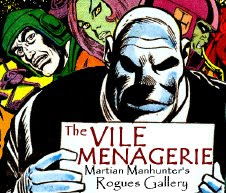


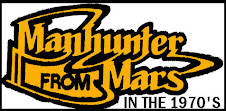
















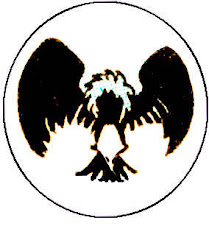




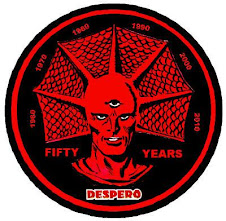
10 comments:
Dang interesting and well written as usual. The mindless ones blog analysis I linked a while back really pulled for this brand of evil Martian, and D'kay in Brightest day is in keeping with it as well.
You sort of touch on this, but I like the idea that Malefic represents Martians as not just cookie cutter J'onn J'onzz; Like humans, Martians should have varied skill sets, body types and personalities. Malefic fits nicely into this mold.
I truly enjoyed this entry, as Malefic is one of the few characters in the DC Universe who could probably creep out most of the villains of the DC Universe. Yes, he can be seen as somewhat shallow and one dimensional, but I can also see some wealth for character development. (Evil is not as interesting as good, and ultimately is about egotism -- only the Self is a person and all others are objects.)
All cultures have flaws, and perhaps you showed that there were problems on Mars before Malefic. A mother who gave the child a better name and was more nurturing could have prevented a tragedy. (Perhaps she was obsessed with her prophetic gifts.)
I do agree that J'Onn should be used more effectively, and a battle with Malefic or a character like him would be a way to show it. (I have previously stated that there should be a few people in the DC Universe on par with the Man of Steel so that we don't get the Super-Duper-Uber Man of the Silver Age.)
Well done, Frank!!!
Thanks guys! This one was a beast to work on. While my other recent entries were already begun before I'd published their preceding post, this one still needs work after three weeks. I've made no secret of my dislike of the character, but thinking about this really made me aware of the highs and lows of the concept. I appreciate what Malefic brings to the table, even if I still turn my nose up at the actual character.
I think that the application is flawed, but the potential is tremendous. The image of the evil twin goes back very far in Western society.
Even if the character is not the best written, there is still potential. Honestly, a well written version or an update should be enough to make most heroes and villains shake in their boots. (I get the feeling that if Malefic was better known and more active, villains would try to scare each other with Joker and Malefic stories. I think both would rank very high on Dr. Stone's Scale of Evil. Hmm, has anyone ever ranked Batman's or Superman's villains on that scale?)
I do believe Malefic is scarier than the Joker, who can be entertained without resorting to the Martian's depths of depravity. Also, Joker's a wussy unless he's armed, and even still...
Re: The additions
Conduit and Hush are both reasonably well liked at my house. Hush moreso when we is written by Dini than by Loeb. Ocean Master seems like he could be either awesome or a chump.
The Master Gardener strikes me as a bit of a Bond villain, and that is perfect.
The Osprey still needs a flashback beating in my opinion.
Conduit got a really cool action figure that came with a Joe Jusko trading card. That should have counted for something. I thought ol' Kenny Braverman was alright, and Superman needs all the decent rogues he can get. I'd sure enough take him over the damned Cyborg.
"Hush" was so bad, I never gave Tommy Elliot another shot. Since they brought back Jason Todd anyway, the fake reveal maybe should have held true.
I haven't done any interviewers, but I'd love to hit Priest up on what happened with the Osprey.
Malefic is scarier than the Joker and should be loathsome. The question is how to not make such a character tedious. A great hero needs great villains.
There should be some figures whom everyone loves to hate, but they have to be made original. I don't know if Malefic will ever return, but perhaps something can be done to make him more distinctive and interesting. (We still don't have a clear idea of his motivation. Perhaps like Heath Ledger's Joker, he just wants to see things burn.)
I OWN that Conduit action figure! I also dig Conduit BUT that is a function of when I started reading Superman comics.
Now then: great article. Malefic is in many ways the perfect foil for the Manhunter, assuming that Despero is a "JLA-level threat" and not someone which DC would let J'Onn hold onto as his own. Your discussion of him representing J'Onn if he were to "cut loose" is very compelling.
Nice work.
I've been a sucker for action figures with removable masks since Lando Calrissia in the skiff guard disguise. Unlike most, Braverman's face didn't look smooshed underneath. It was a really nice costume design, and the twirling conduits were actually functional.
Post a Comment